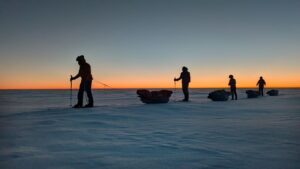In 1897, mechanical engineer and pioneering Swedish balloonist Salomon August Andree tried to reach the North Pole in a hydrogen balloon. At the time, being the first to the North Pole was all the rage, like summiting Everest in the early 1950s or reaching the moon in the 1960s.
For Andree and his two companions, Knut Fraenkel and Nils Strindberg (cousin of Sweden’s most famous playwright, August Strindberg), it was a fatal obsession. They disappeared, and their remains were not discovered for over 30 years.
However, the unexpected arrival of a homing pigeon in Syracuse, New York seemed to hold a clue to this renowned arctic mystery. Alas, it turned out to be an unusual hoax that led to more questions than answers.
Public fascination
This pigeon hoax took place a year after all communication from Andree and his team had ceased. Speculation from the public was at an all-time high. Newspapers regularly reported rumors of their whereabouts.
Writer Johnathan Croyle with syracuse.com delves into this intriguing tale. It centers on the arrival of a homing pigeon at an obscure hospital in Syracuse, New York. According to Croyle, a staff member came across a starving and injured pigeon in the attic of St. Joseph’s Hospital.
It carried a cryptic message saying “Latitude 85 degrees 43’; Longitude 15 degrees east. We are going very slowly. Very cold. Dogs are dead -– Andree, August 17.”
The message was written in French. Despite inconsistencies with Andree’s previous messages and other important details, the local press still ran with it. Some people believed that this bird had carried Andree’s words and location all the way from the European Arctic to New York.
Others were not so easily convinced. Eventually, the whole incident proved a fake. First, Andree and his team never took dogs on their expedition. Rather, their inventory consisted of a multi-layered silk balloon and a large basket for the three men and their food and equipment.
In it, they had tents, a boat, weapons for hunting, skis, meats, dairy products, and even alcohol for celebration. These supplies were enough to sustain them for three-and-a-half months.

Strindberg hauls a sled on snowshoes. Photo: Salomon Andree or Knut Fraenkel
Homing pigeons
It’s true that they had cages with homing pigeons, and Andree sent four of the birds out. Only one message, from July 13, stating their coordinates at the time and overall positive news, was found and authenticated. It read:
From Andrée’s polar expedition to Aftonbladet, Stockholm, July 13, 12:30 pm, 82 degrees 2 minutes north latitude, 15 degrees 5 minutes east longitude…everything well on board. This is my third message by carrier pigeon.
He wrote not in French but in Swedish. More detailed, and in a completely different writing style, Andree’s message differs greatly from the one on the New York pigeon.
Finally, the New York pigeon’s band had an odd insignia unrelated to anything from Andree or his team. According to Croyle, it greatly resembled the insignia of a local homing pigeon club in Syracuse. Coincidence? Definitely not.
Motivations
Why on earth would a pigeon from a doomed arctic expedition show up in Syracuse, New York? Perhaps the motive was just a prank. Other notable hoaxes occurred in the U.S. in 1897, including several early UFO reports. The most famous of these, concocted at a local Liars’ Club, reported a crash of a ship, complete with an alien body, near Aurora, Texas in April of that year. Sometimes editors simply concocted these stunts to increase circulation.
This hoax is not even the first of its kind relating to balloons. Almost half a century earlier, in October 1851, a balloon carrying a supposed message from Sir John Franklin’s lost Northwest Passage expedition ended up in a garden in Gloucester, England. The message supposedly provided the coordinates of Franklin’s HMS Erebus, the date, and the men’s current condition. Franklin and 129 men had set off in 1845 and had likewise vanished.
However, authorities determined it a hoax, and the culprit remains anonymous. Arctic scholar Russell Potter suggests that someone may have had a theory about where the expedition was and tried to prompt a search of that location. Perhaps the same motive was at play with the Andree expedition.

The crew of Andree’s balloon expedition with a dead polar bear. Eating its uncooked meat may have been the cause of the trio’s demise. Photo: Salomon August Andree
The truth
While several expeditions searched for them and came back empty-handed, a Norwegian expedition studying glaciers found a makeshift camp, artifacts, and the men’s remains 33 years later. Andree’s diary told what befell the men.
The expedition began smoothly. However, their hydrogen balloon steadily lost gas. Eventually, their ride became a very bumpy one, and they crash-landed on the arctic ice just two days or so after their launch.
They trudged eastwards for a few weeks, suffering from frostbite, snow blindness, and severe stomach ailments. They managed to paddle out to an island called Kvitøya (translated into English as White Island) in the Svalbard archipelago in their boat. Here, Andree’s diary showed a gradual decline in the men’s mental and physical health. Ultimately, they all perished.
There was much controversy about Andree’s conduct on this expedition. Many criticized him for not ensuring the balloon’s capabilities in harsh Arctic weather and for his zealous but pseudo-scientific approach to ballooning. Most historians blamed trichinella parasites from undercooked polar bear meat, scurvy, vitamin A poisoning (from eating polar bear livers), or hypothermia for their demise.
No further information ever surfaced regarding the source of the pigeon hoax.

Andree’s funeral. Photo: Sven Lundstrom’s book “Vår position är ej synnerligen god…”






